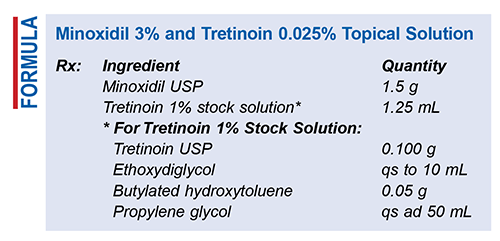US Pharm. 2023;48(6):59-60.

Method of Preparation: Calculate the required quantity of each ingredient for the total amount to be prepared. Accurately weigh or measure each ingredient. First, make the tretinoin 1% stock solution by adding the tretinoin powder to a beaker, adding approximately 9 mL of ethoxydiglycol, and mixing until the powder is fully dissolved. Next, triturate the minoxidil and butylated hydroxytoluene (BHT) in a mortar until it is a fine, homogenous powder. Add the correct volume of tretinoin 1% stock solution and levigate the powder with the solution; then mix continuously until the mixture is completely dissolved and homogenous. Transfer to a calibrated bottle. Rinse the mortar with propylene glycol (PG) and bring final volume to 50 mL. Package and label.
Use: Minoxidil and tretinoin topical solution is used to treat androgenic alopecia and enhance hair growth.1
Packaging: Package in a tight, light-resistant container. Store at controlled room temperature.
Labeling: Keep out of reach of children. For external use only. Protect from light. Shake well. Discard after ____ [time period].
Stability: The USP default beyond-use date for nonaqueous liquids is 180 days when they are stored at controlled room temperature or in a refrigerator.2
Quality Control: Quality-control assessment can include weight/volume, pH, specific gravity (SG), active drug assay, color, rheologic properties/pourability, physical observation, and physical stability (discoloration, foreign materials, gas formation, mold growth).3
Discussion: Minoxidil (Loniten, Rogaine, C9H15N5O, MW 209.25) is a hair stimulant and piperidinopyrimidine-derivative vasodilator. It is a white or off-white, odorless, crystalline solid that is slightly soluble in water (about 2 mg/mL), readily soluble in PG or ethanol, and practically insoluble in acetone or ethyl acetate. Minoxidil melts at 248°C to 268°C with decomposition. The 2% topical solution includes 63% alcohol, 20% PG, and water; the foam formulation includes SD alcohol 40B, purified water, BHT, lactic acid, citric acid anhydrous, glycerol anhydrous, cetyl alcohol, stearyl alcohol, polysorbate 60, and propellant.1,4
Tretinoin (C20H28O2, MW 300.44), a vitamin A retinoid derivative, is a yellow to light-orange crystalline powder that is insoluble in water and slightly soluble in alcohol and most organic solvents. Tretinoin is sensitive to light, heat, and air, especially when in solution.5 Combining tretinoin with minoxidil improves minoxidil’s absorption into the skin, increasing its effectiveness.5,6
BHT (C15H24O, MW 220.35) is a synthetic antioxidant used to prevent oxidation of a product’s ingredients and extend its shelf life. It is a white or light-yellow crystalline powder or solid with a faint odor. BHT is practically insoluble in water, glycerin, PG, alkali hydroxide solutions, and dilute aqueous mineral acids but is freely soluble in ethanol, methanol, fixed oils, and liquid paraffin.7
Ethoxydiglycol (CH2OHCH2OCH2CH2OC2H5, C6H14O3, MW 134.20) is also called diethylene glycol monoethyl ether, diethylene glycol ethyl ether, transcutol, and carbitol. This colorless liquid with a mild odor has a density of 1.0272. Ethoxydiglycol is a hygroscopic organic solvent that can be mixed with water and other organic solvents. It improves the solubility and permeability of active ingredients and acts as a solubilizer and cosurfactant. It is nonirritating and nonpenetrating when applied to human skin.8
PG (C3H8O2) is a clear, colorless, odorless, viscous liquid with a sweet taste, similar to glycerin. It has an SG of 1.038 g/mL and is miscible with acetone, chloroform, 95% ethanol, glycerin, and water; however, it is not miscible with fixed oils or light mineral oil. PG is used in topicals as a humectant; in solutions and semisolids as a preservative; and in aerosols, oral solutions, parenterals, and topicals as a solvent or cosolvent. It may also be used to transport flavors and emulsifiers. PG is stable and may be mixed with various other solvents. Because it is hygroscopic, it should be stored in an airtight container and protected from light.9
REFERENCES
1. Badri T, Nessel TA, Kumar DD. Minoxidil. In: StatPearls [Internet]. Treasure Island, FL: StatPearls Publishing; 2023 Jan-.
2. U.S. Pharmacopeia/National Formulary [current revision]. Rockville, MD: U.S. Pharmacopeial Convention, Inc; September 2022.
3. Allen LV Jr. Standard operating procedure for quality assessment of oral and topical liquids. IJPC. 1999;3:146-147.
4. Drugs.com. Minoxidil (topical) (monograph). www.drugs.com/ppa/minoxidil-topical.html. Accessed May 6, 2023.
5. Tretinoin. In: Sweetman SC, ed. Martindale: The Complete Drug Reference. 35th ed. London, England: Pharmaceutical Press; 2007:1455-1456, 2116.
6. Tretinoin (monograph). United States Pharmacopeia XXXIX/National Formulary 34. Rockville, MD: U.S. Pharmacopeial Convention, Inc; 2016:6232.
7. Guest RT. Butylated hydroxytoluene. In: Rowe RC, Sheskey PL, Quinn ME, eds. Handbook of Pharmaceutical Excipients. 6th ed. Washington, DC: American Pharmaceutical Association; 2009:75-76.
8. Ash M, Ash I. Handbook of Pharmaceutical Additives. Brookfield, VT: Gower Publishing Ltd; 1995:484.
9. Weller PJ. Propylene glycol. In: Rowe RC, Sheskey PJ, Quinn ME, eds. Handbook of Pharmaceutical Excipients. 6th ed. Washington, DC: American Pharmaceutical Association; 2009:592-594.
The content contained in this article is for informational purposes only. The content is not intended to be a substitute for professional advice. Reliance on any information provided in this article is solely at your own risk.
To comment on this article, contact rdavidson@uspharmacist.com.





